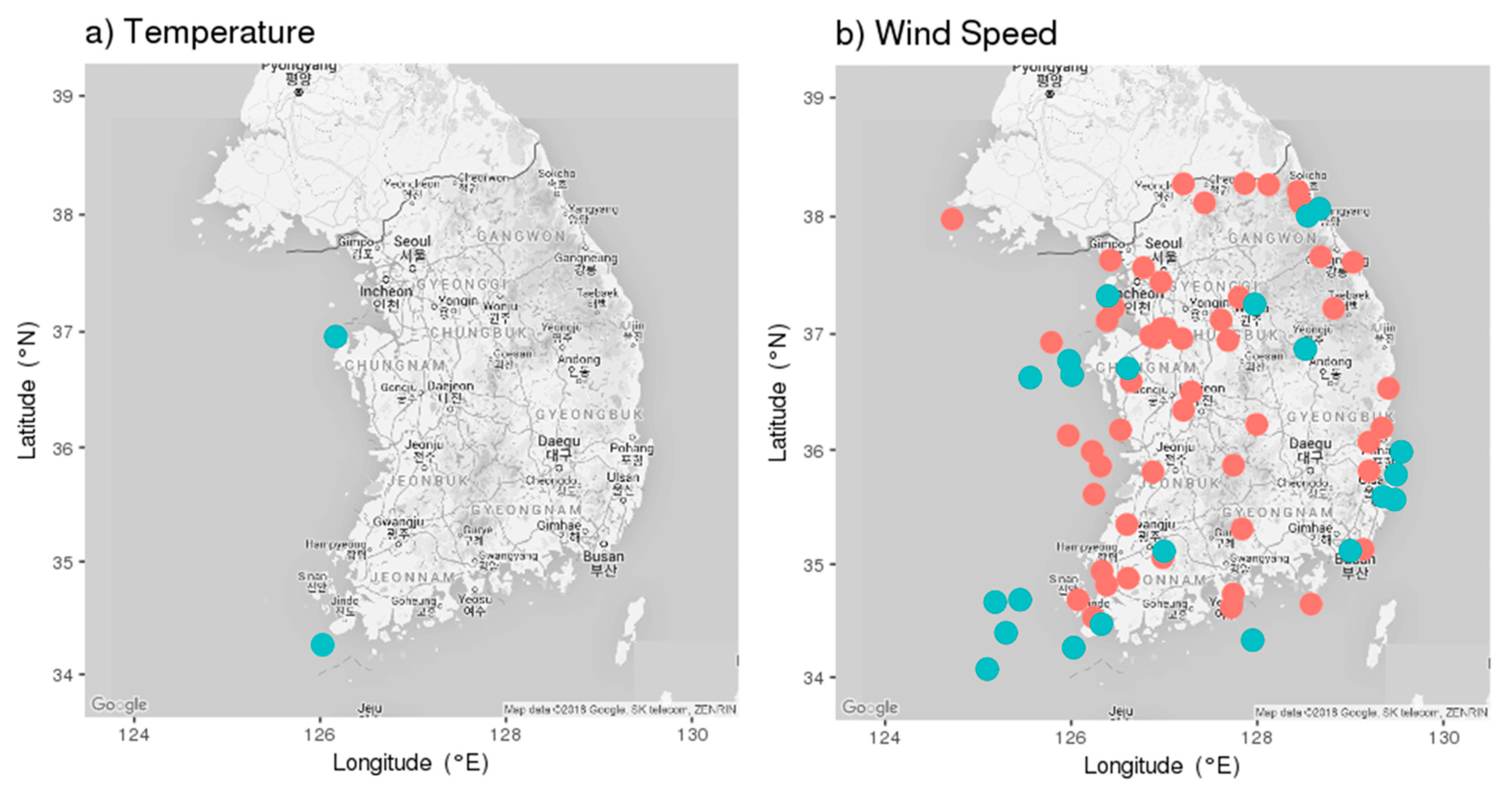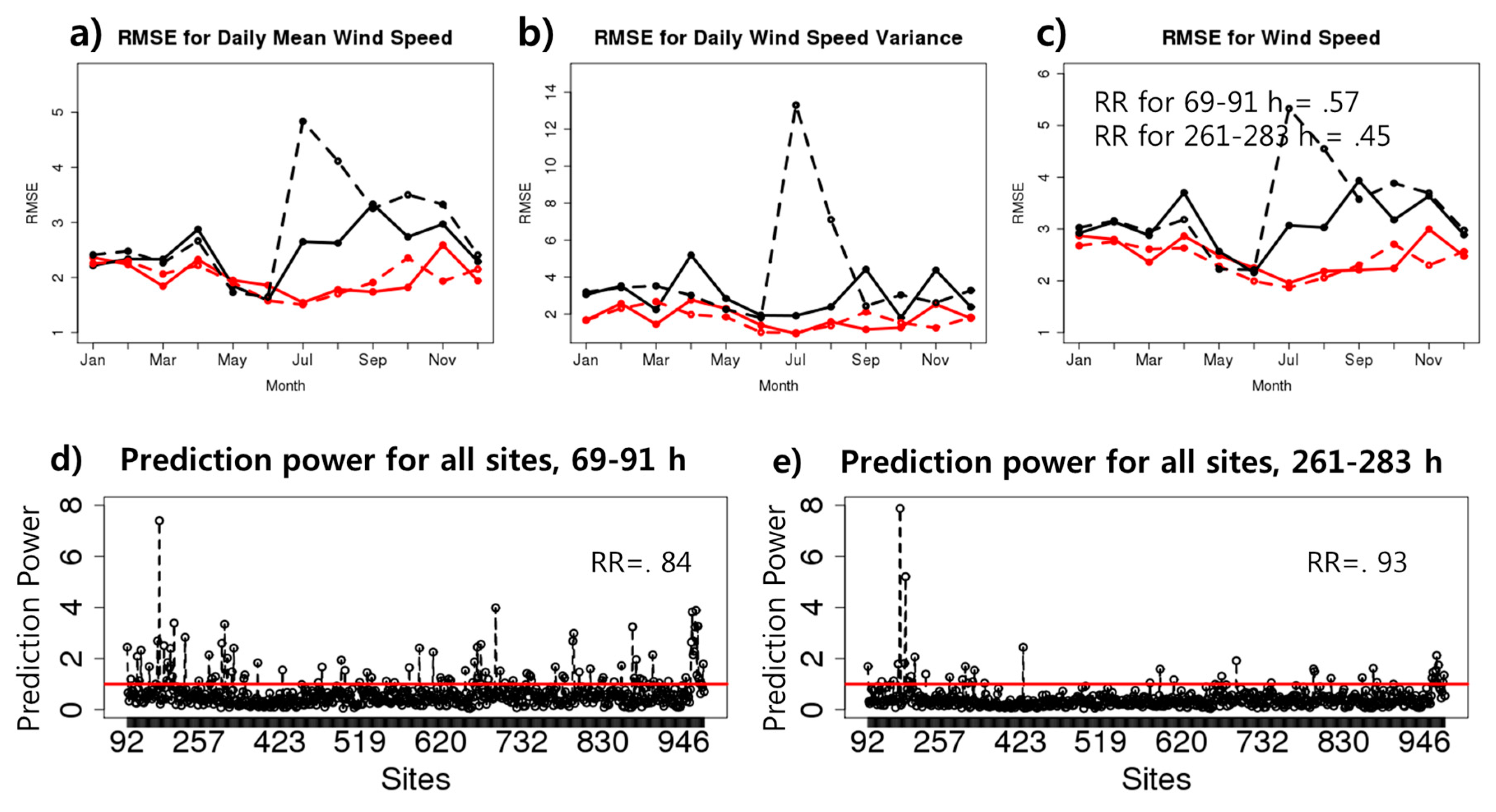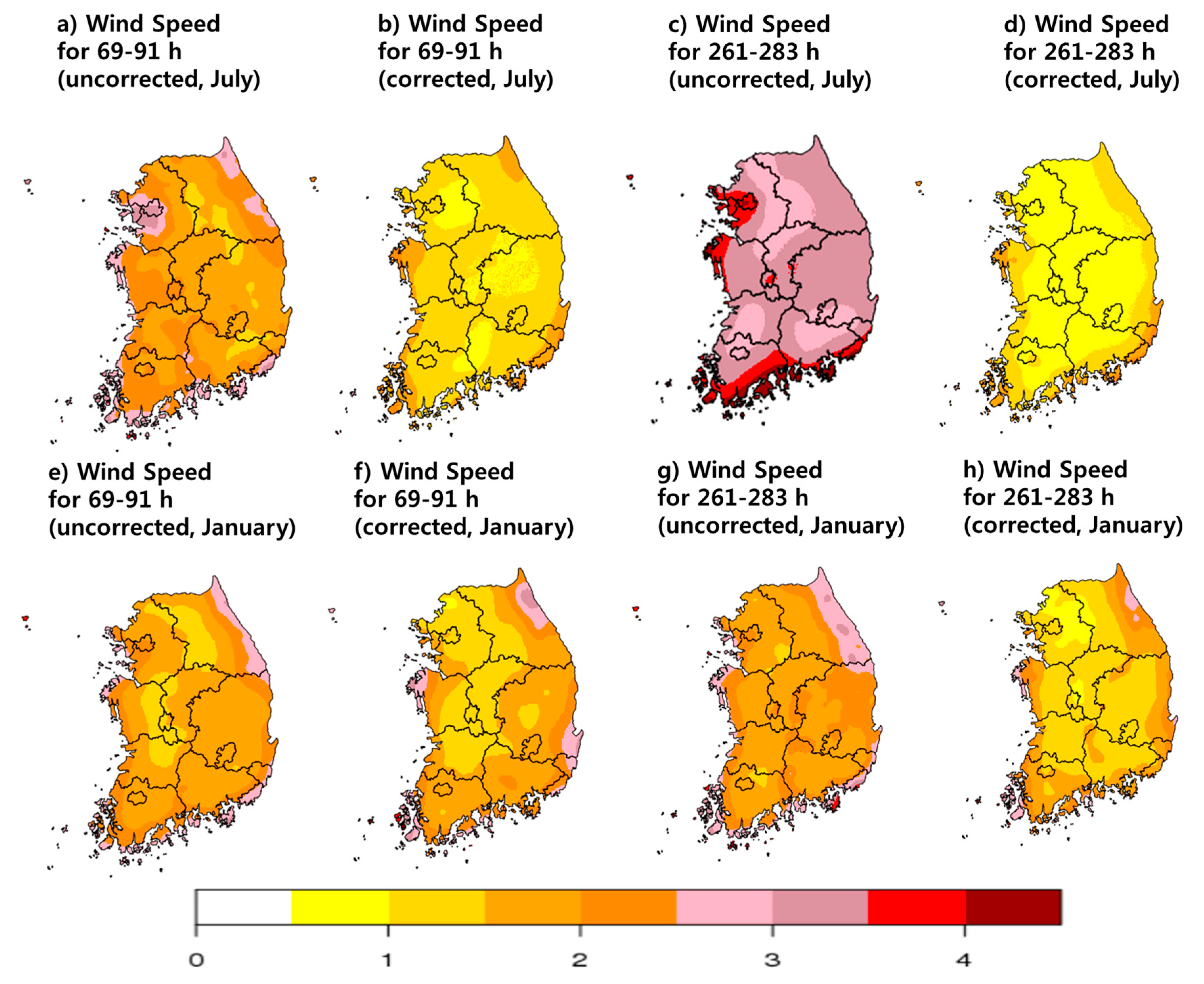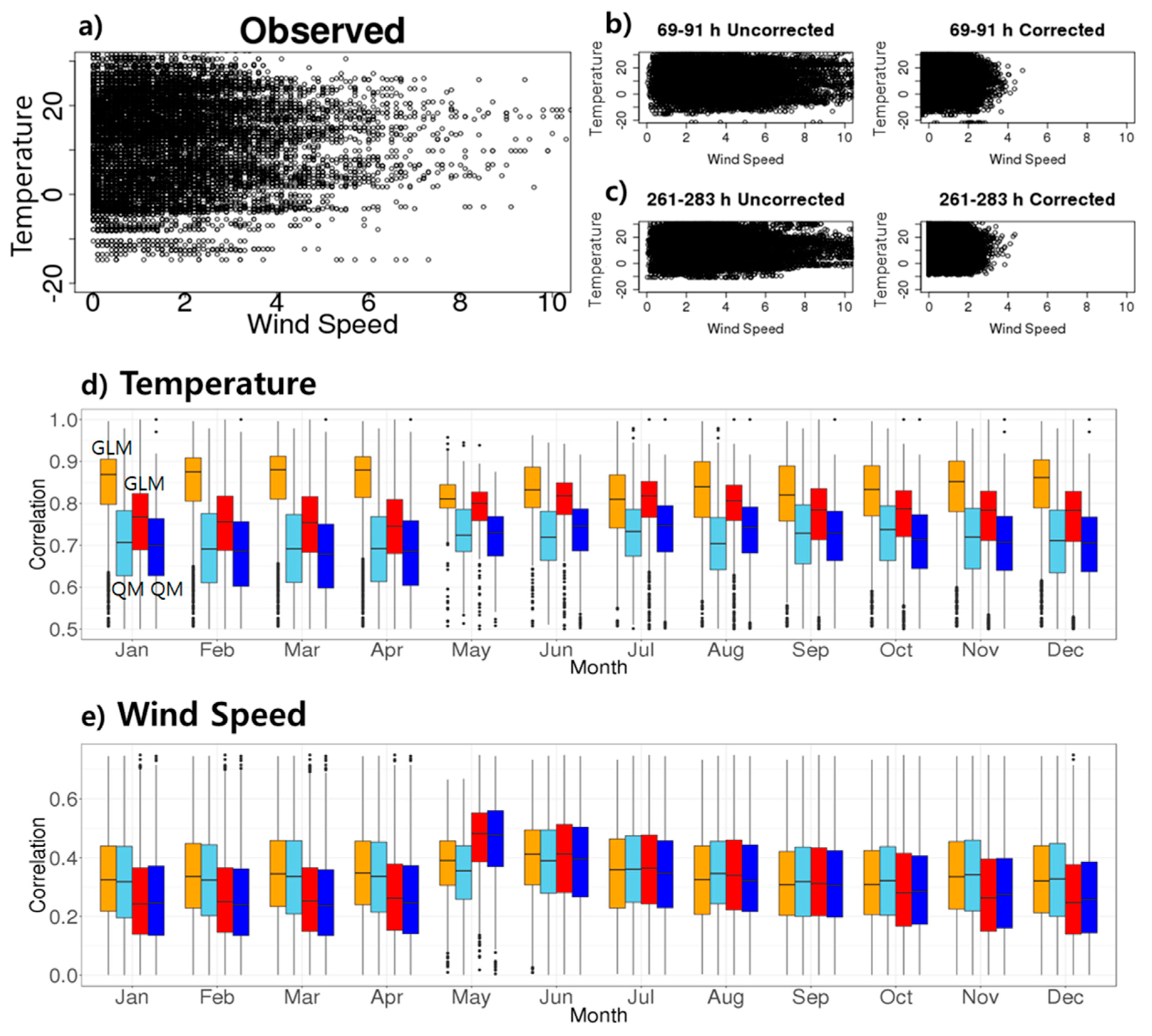A Statistical Parameter Correction Technique for WRF Medium-Range Prediction of Near-Surface Temperature and Wind Speed Using Generalized Linear Model
Abstract
:1. Introduction
2. Data and Methodology
3. Results and Discussion
3.1. Temperature
3.2. Wind Speed
3.3. Performance of Bias Correction and Discussions
4. Summary and Concluding Remarks
Author Contributions
Acknowledgments
Conflicts of Interest
References
- Kim, Y.; Shim, K.M.; Jung, M.P.; Choi, I. Study on the Estimation of Frost Occurrence Classification Using Machine Learning Methods. Korean J. Agric. For. Meteorol. 2017, 19, 86–92. [Google Scholar]
- Lee, S.-J.; Song, J.; Kim, Y. The NCAM Land-Atmosphere Modeling Package (LAMP) Version 1: Implementation and Evaluation. Korean J. Agric. For. Meteorol. 2016, 18, 307–319. [Google Scholar] [CrossRef] [Green Version]
- Lee, S.-J.; Kim, J.; Kang, M.; Takuri, B.M. Numerical Simulation of Local Atmospheric Circulation in the Valley of KoFlux Observation Site. Korean J. Agric. For. Meteorol. 2014, 16, 244–258. [Google Scholar]
- Song, J.; Lee, S.-J.; Kang, M.; Moon, M.; Lee, J.; Kim, J. Numerical Simulation of High Resolution WRF/Noah-MP in Farmland around Cheongmicheon Stream during the Special Observation Period. Korean J. Agric. For. Meteorol. 2015, 17, 384–398. [Google Scholar] [CrossRef]
- Hoffman, R.N.; Kalnay, E. Lagged average forecasting, an alternative to Monte Carlo forecasting. Tellus 1983, 35, 100–118. [Google Scholar] [CrossRef]
- Matsueda, M.; Kyouda, M.; Tanaka, H.L.; Tsuyuki, T. Daily Forecast Skill of Multi-Center Grand Ensemble. SOLA 2007, 3, 29–32. [Google Scholar] [CrossRef] [Green Version]
- Rixen, M.; Le Gac, J.-C.; Hermand, J.-P.; Peggion, G.; Coelho, E. Super-ensemble Forecast and Resulting Acoustic Sensitivities in Shallow Waters. J. Mar. Syst. 2009, 78, 290–305. [Google Scholar] [CrossRef]
- Zhao, J.; Xu, J.; Xie, X.; Lu, H. Drought Monitoring Based on TIGGE and Distributed Hydrological Model in Huaihe River Basin, China. Total Envrion. 2016, 553, 358–365. [Google Scholar] [CrossRef] [PubMed]
- Pistoia, J.; Pinardi, N.; Oddo, P.; Collins, M.; Korres, G.; Drillel, Y. Development of Super-ensemble Techniques for Ocean Analyses: The Mediterranean Sea Case. Nat. Hazards Earth Syst. Sci. 2016, 16, 1807–1819. [Google Scholar] [CrossRef]
- Hwang, Y.; Han, K.; Kim, C. Coupling and Correction of Multi-model Ensemble. In Proceedings of the Autumn Meeting of Korea Meteorological Society, Busan, Korea, 25–27 October 2017; pp. 408–409. [Google Scholar]
- Glahn, H.R.; Lowry, R. The Use of Model Output Statistics (MOS) in Objective Weather Forecasting. J. Appl. Meteorol. 1972, 11, 1203–1211. [Google Scholar] [CrossRef]
- Lorenz, E.N. An Experiment in Nonlinear Statistical Weather Forecasting. Mon. Weather Rev. 1977, 105, 590–602. [Google Scholar] [CrossRef] [Green Version]
- Massie, R.D.; Rose, M.A. Predicting Daily Maximum Temperatures Using Linear Regression and Eta Geopotential Thickness Forests. Weather Forecast. 1997, 12, 799–807. [Google Scholar] [CrossRef]
- Myoung, J.; Oh, S.; Suh, M. Improvement of Simulated Air Temperature of Regional Climate Model using Linear Regression Method. Clim. Res. 2012, 7, 255–270. [Google Scholar]
- Termonia, P.; Deckmyn, A. Model-inspired Predictors for Model Output Statistics (MOS). Mon. Weather Rev. 2007, 135, 3496–3505. [Google Scholar] [CrossRef]
- Lee, B.; Kang, B. Downscaling GCM Climate Change Output using Quantile Mapping and Artificial Neural Network. In Proceedings of the Korean Society of Civil Engineers, Daegu, Korea, 29–30 October 2008; pp. 1603–1606. [Google Scholar]
- Marzban, C. Neural Networks for Postprocessing Model Output: ARPS. Mon. Weather Rev. 2003, 131, 1103–1111. [Google Scholar] [CrossRef] [Green Version]
- Vislocky, R.L.; Fritsch, J.M. Generalized Additive Models versus Linear Regression in Generating Probabilistic MOS Forecasts of Aviation Weather Parameters. Weather Forecast. 1995, 10, 669–680. [Google Scholar] [CrossRef] [Green Version]
- Bordoy, R.; Burlando, P. Bias Correction of Regional Climate Model Simulations in a Region of Complex Orography. J. Appl. Meteorol. Clim. 2013, 52, 82–101. [Google Scholar] [CrossRef]
- Seo, Y.; Choi, J.; Lee, J.; Jeong, H. Improvement of Statistical Model (MOS) for Supporting Digital Weather Forecast. In Proceedings of the Autumn Meeting of Korea Meteorological Society, Daegu, Korea, 1–2 November 2012; pp. 110–111. [Google Scholar]
- Odo, F.C.; Offiah, S.U.; Ugwuoke, P.E. Weibull Distribution-based Model for Prediction of Wind Potential in Enugu, Nigeria. Adv. Appl. Sci. Res. 2012, 3, 1202–1208. [Google Scholar]
- Kim, H.-J.; Kim, H.; Choi, Y.; Lee, S.; Seo, B. A Statistical Tuning Method to Improve the Accuracy of 1 km × 1 km Resolution Wind Data of South Korea Generated from a Numerical Meteorological Model. Korean J. Appl. Stat. 2011, 24, 1225–1235. [Google Scholar] [CrossRef]
- Zamo, M.; Bel, L.; Mestre, O.; Stein, J. Improved Gridded Wind Speed Forecasts by Statistical Postprocessing of Numerical Models with Block Regression. Weather Forecast. 2016, 31, 1929–1945. [Google Scholar] [CrossRef]
- Piani, C.; Haerter, J.O.; Coppola, E. Statistical Bias Correction for Daily Precipitation in Regional Climate Models over Europe. Theor. Appl. Clim. 2010, 99, 187–192. [Google Scholar] [CrossRef]
- Piani, C.; Weedon, G.P.; Best, M.; Gomes, S.M.; Viterbo, P.; Hagemann, S.; Haerter, J.O. Statistical Bias Correction of Global Simulated Daily Precipitation and Temperature for the Application of Hydrological Models. J. Hydrol. 2010, 395, 199–215. [Google Scholar] [CrossRef]
- Wilcke, R.A.; Mendlik, T.; Gobiet, A. Multi-variable error correction of regional climate models. Clim. Chang. 2013, 120, 871–887. [Google Scholar] [CrossRef] [Green Version]
- Gutiérrez, J.M.; Maraun, D.; Widmann, M.; Huth, R.; Hertig, E.; Benestad, R.; Roessler, O.; Wibig, J.; Wilcke, R.; Kotlarski, S.; et al. An Intercomparison of a Large Ensemble of Statistical Downscaling Methods over Europe: Results from the VALUE Perfect Predictor Cross-validation Experiment. Int. J. Clim. 2018. [Google Scholar] [CrossRef]
- Maraun, D.; Widmann, M. Cross-validation of Bias-corrected Climate Simulations is Misleading. Hydrol. Earth Syst. Sci. Discuss. 2018. [Google Scholar] [CrossRef]
- Lee, S.-J.; Parrish, D.F.; Wu, W.-S.; Park, S.-Y.; Greybush, S.J.; Lee, W.-J.; Lord, S.J. Effects of 2-m Air Temperature Assimilation and a New Near-Surface Observation Operator on the NCEP Gridpoint Statistical-Interpolation System. Asia-Pac. J. Atmos. Sci. 2011, 47, 353–376. [Google Scholar] [CrossRef]








| Domain | Domain 1 | Domain 2 | Domain 3 | Domain 4 |
|---|---|---|---|---|
| (D01) | (D02) | (D03) | (D04) | |
| Model version | WRF–ARW v3.7.1 with Noah-MP land surface model | |||
| Domain size (horizontal resolution) | 175 × 151 | 250 × 250 | 250 × 250 | 130 × 130 |
| (21,870 m) | (7290 m) | (2430 m) | (810 m) | |
| Vertical levels | 39 | 39 | 39 | 39 |
| Topography and land use data resolution (data source) | 30″ | 30″ | 30″ | 1/3″ |
| (USGS) | (USGS) | (USGS) | (Ministry of Environment) | |
| Initial and boundary conditions | UM–GDAPS (Unified Model—Global Data Assimilation and Prediction System at Korea Meteorological Administration) | |||
| Shortwave radiation scheme | Goddard shortwave | |||
| Longwave radiation scheme | RRTM | |||
| Microphysics scheme | WSM6 | |||
| Cumulus scheme | New Kain–Fritsch | New Kain–Fritsch | Off | Off |
| Planetary boundary layer scheme | Shin–Hong | |||
© 2018 by the authors. Licensee MDPI, Basel, Switzerland. This article is an open access article distributed under the terms and conditions of the Creative Commons Attribution (CC BY) license (http://creativecommons.org/licenses/by/4.0/).
Share and Cite
Jeong, J.; Lee, S.-J. A Statistical Parameter Correction Technique for WRF Medium-Range Prediction of Near-Surface Temperature and Wind Speed Using Generalized Linear Model. Atmosphere 2018, 9, 291. https://doi.org/10.3390/atmos9080291
Jeong J, Lee S-J. A Statistical Parameter Correction Technique for WRF Medium-Range Prediction of Near-Surface Temperature and Wind Speed Using Generalized Linear Model. Atmosphere. 2018; 9(8):291. https://doi.org/10.3390/atmos9080291
Chicago/Turabian StyleJeong, Jinmyeong, and Seung-Jae Lee. 2018. "A Statistical Parameter Correction Technique for WRF Medium-Range Prediction of Near-Surface Temperature and Wind Speed Using Generalized Linear Model" Atmosphere 9, no. 8: 291. https://doi.org/10.3390/atmos9080291




